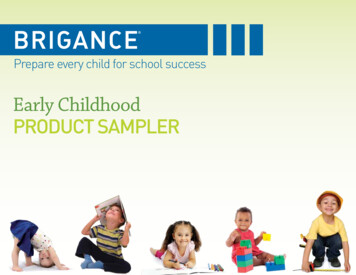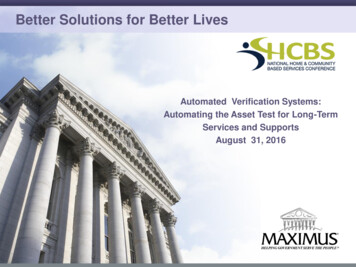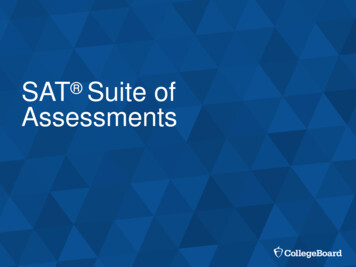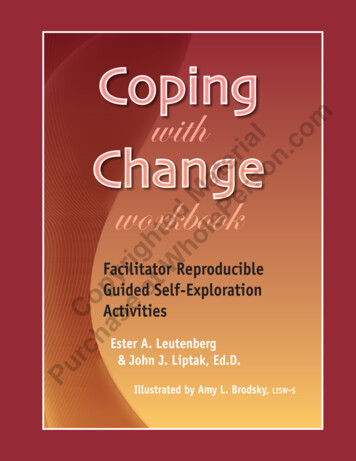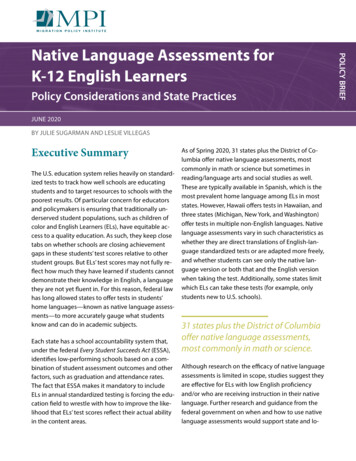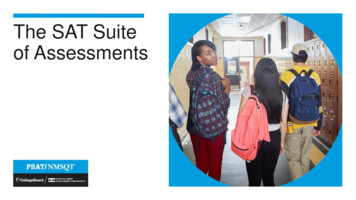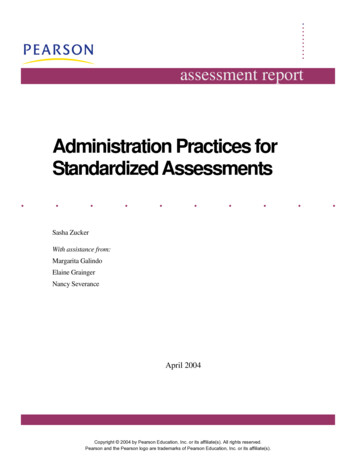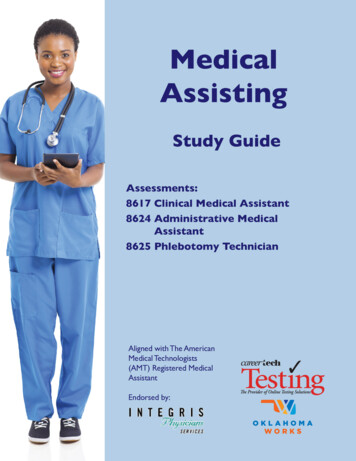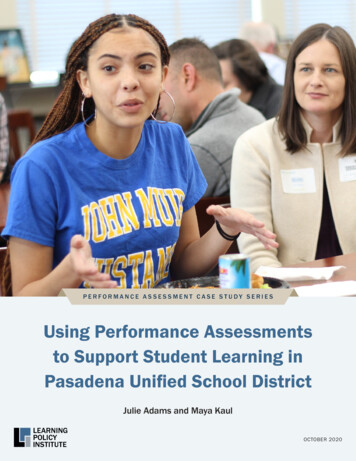
Transcription
PERFORMANCE AS SE S SMENT CASE STUDY SERIE SUsing Performance Assessmentsto Support Student Learning inPasadena Unified School DistrictJulie Adams and Maya KaulOCTOBER 2020
PERFORMANCE AS SES SMENT CASE STUDY SERIE SUsing PerformanceAssessments to SupportStudent Learning in PasadenaUnified School DistrictJulie Adams and Maya Kaul
AcknowledgmentsThe authors thank the many teachers, site coordinators, and district personnel at Pasadena UnifiedSchool District who welcomed us into their schools for observations and who shared their valuabletime with us during focus groups and interviews. Thank you to each of the individuals who helpedcoordinate our data collection at each school site. We thank the students who allowed us to sit inon their presentations and took the time to participate in focus groups. Special thanks to KristinaTurley-Payne and Sofia Valadez-Paez, who volunteered their time for thoughtful review, feedback,and general guidance on the study.We are also grateful to Roneeta Guha for her substantial contributions to the design of this studyand for data collection. Additional thanks are owed to Marisa Saunders and our LPI colleagues DionBurns, Linda Darling-Hammond, Jennifer DePaoli, Anna Maier, Monica Martinez, Caitlin Scott, andCharlie Thompson for their time collecting data, reviewing multiple versions of this case, sharingtheir insights, and providing feedback. In addition, we thank Erin Chase and Aaron Reeves for theirediting and design contributions to this project and the entire LPI communications team for itsinvaluable support in developing and disseminating this report. Without their generosity of timeand spirit, this work would not have been possible.This research was supported by the Stuart Foundation. Core operating support for the LearningPolicy Institute is provided by the Heising-Simons Foundation, Raikes Foundation, SandlerFoundation, and William and Flora Hewlett Foundation. We are grateful to them for their generoussupport. The ideas voiced here are those of the authors and not those of our funders.External ReviewersThis report benefited from the insights and expertise of one external reviewer: Ann Jaquith,Associate Director of the Stanford Center for Opportunity Policy in Education. We thank her for thecare and attention she gave the report.The appropriate citation for this report is: Adams, J., & Kaul, M. (2020). Using performanceassessments to support student learning in Pasadena Unified School District. Palo Alto, CA: LearningPolicy Institute.This report can be found online at istrict-initiatives-assess-student-learning.Cover photo provided with permission by Pasadena Unified School District.This work is licensed under the Creative Commons Attribution-NonCommercial 4.0 InternationalLicense. To view a copy of this license, visit ument last revised October 9, 2020iiLEARNING POLICY INSTITUTE PERFORMANCE ASSESSMENTS IN PASADENA UNIFIED SCHOOL DISTRICT
Table of ContentsExecutive Summary. vIntroduction.1District Context for Performance Assessments.3About Pasadena Unified School District .3Historical Context of Performance Assessments in Pasadena Unified .5Implementing a Performance Assessment Initiative Through District Policy.7How the Senior Defense Works. 10Student Work. 11Scoring and Feedback. 12Systems of Support. 14Teacher Supports. 14School Administrator Supports. 16Student Supports . 17Funding and Technical Assistance. 18Conditions That Support the Implementation of a High-QualityPerformance Assessment Initiative. 20A Supportive Policy and Practice Environment. 20A Strong Vision and District-Led Policy. 22Access to Resources and Technical Assistance. 24Multiple, Varied Opportunities to Observe Performance Assessments in Action . 27A Plan for Implementation. 30Meaningful Learning for Students and Teachers . 35Broadening Student Outcomes . 35Supporting Instructional Practice and Improvement . 38Lessons Learned. 42Conclusion. 44Appendix A: Methodology. 46Appendix B: Graduate Profile Quality Criteria Check. 49Appendix C: Research Rubric. 50Appendix D: Creativity/Innovation Rubric. 51Appendix E: Written Communication/Reflection Rubric. 52LEARNING POLICY INSTITUTE PERFORMANCE ASSESSMENTS IN PASADENA UNIFIED SCHOOL DISTRICTiii
Appendix F: Oral Communication/Presentation Rubric. 53Appendix G: Districtwide Requirement With Two Options for Students During a Pandemic. 54Endnotes. 55About the Authors. 59List of Figures and TablesFigure 1Pasadena Unified Graduate Profile.7Figure 2Plan to Develop and Scale the Senior Defense.8Table 1Pasadena Unified at a Glance (2018–19).4Table 2Pasadena Unified’s College and Career Academies and High Schools.6ivLEARNING POLICY INSTITUTE PERFORMANCE ASSESSMENTS IN PASADENA UNIFIED SCHOOL DISTRICT
Executive SummaryA lot of [students] have said, “I’ve never had to do anything like [the seniordefense]. And I learned a lot about myself.” That’s really exciting, especially thesense that we’re giving students the opportunity to do this before they step out intoa bigger venue.This reflection was shared by a district-level administrator in Pasadena Unified School District(Pasadena Unified) and refers to the experience Pasadena Unified students have completing aperformance assessment called the senior defense. This performance assessment requires allgraduating students in Pasadena Unified to curate a collection of their work, including a researchpaper, and present to a judging panel consisting of teachers, peers, and/or community members.The senior defense became a graduation requirement for all students in Pasadena Unified startingwith the graduating class of 2019. After 4 years of planning and capacity building, Pasadena Unifiedsaw every senior complete a senior defense during the 2018–19 school year.Pasadena Unified introduced the senior defense to help each student develop the skills, abilities,and mindsets associated with the district’s ideal graduate. These include critical, creative, andinnovative thinking; effective communication and collaboration; a healthy mind and body;cultural competence; and students being prepared for college and the career(s) of their choice.The characteristics of the ideal graduate are articulated in Pasadena Unified’s graduate profile—aunified vision for student outcomes, developed in collaboration with educators, district leaders, andcommunity members. After developing this vision, the Pasadena Unified Board of Education passedthe senior defense as a graduation requirement, signaling a commitment to equitable access tohigh-quality learning for all students.Pasadena Unified’s approach is grounded in research on how performance assessments helpstudents and educators strive for meaningful learning goals, while also reliably assessing studentlearning. Performance assessments encompass a wide variety of activities, all of which requirestudents to show what they know, rather than selecting answers from predetermined optionson a multiple-choice test. Recent reviews of the literature show that well-designed performanceassessments can provide the opportunity for students to demonstrate readiness based on a widerange of activities and under conditions that mirror those in which students will need to apply theirskills in their work beyond secondary school. Further, these reviews demonstrate that performanceassessments can measure outcomes for students of different racial and ethnic groups. Performanceassessments, therefore, can have implications for curriculum, instruction, and school design.This report is part of a series of three case studies examining the key district-, school-, andclassroom-level conditions necessary to support high-quality performance assessment practices.All three districts actively participate in the California Performance Assessment Collaborative(CPAC), a community of educators, researchers, and technical assistance providers who are workingto study and advance the use of performance assessments throughout the state. A cross-casestudy that accompanies this report provides insights across all three case study districts, as well asrecommendations for district policymakers interested in implementing well-designed performanceassessments within their own context.LEARNING POLICY INSTITUTE PERFORMANCE ASSESSMENTS IN PASADENA UNIFIED SCHOOL DISTRICTv
The Pasadena Unified case study draws on data from a range of sources, including documents,district administrative data, interviews with a range of personnel at the district and school levels,focus groups with teachers and students, observations of senior defense presentations, andobservations of professional learning opportunities for teachers and staff. The study is not anevaluation of Pasadena Unified as a whole or of the success of the senior defense initiative withinthe district. Instead, it provides an in-depth description of how Pasadena Unified has attempted toadvance districtwide implementation of the senior defense.Our analysis of data from Pasadena Unified suggests that the following key conditions enabled thedistrict’s performance assessment initiative: A supportive policy and practice environment A strong vision and district-led policy Access to resources and technical assistance Multiple, varied opportunities to observe performance assessment systems A plan for implementationFurther, data from student and teacher interviews and focus groups show that: the first year of the senior defense broadened the ways student outcomes are measured; and the implementation of the senior defense supported instructional practiceand improvement.Based on these findings related to key conditions and perceived student and teacher outcomes, weidentify five of the emerging implications of Pasadena Unified’s performance assessment practicesfor student learning and teacher practice:1. Starting with a clear vision for students’ college and career preparation can be apowerful driving force for implementing performance assessments. By defining aset of skills and competencies for students to develop by the time they graduate, schoolsand districts can think critically about the instructional practices that enable studentsto achieve this goal and the best methods to assess student learning in these areas. ThePasadena Unified story shows how the process of developing a graduate profile can lead toan effort to establish districtwide performance assessments as part of a balanced systemof assessment.2. Having opportunities to observe performance assessments—in addition to receivingclear and consistent messaging about the purpose and components of suchassessments—can help staff, students, parents, and community members see thevalue in this work. Pasadena Unified stakeholders described the importance of seeingstudents engage in defenses of their work. This reportedly helped increase understandingof what performance assessments are and why they are important. After witnessing even asingle instance of students defending and reflecting on their learning, such as the PasadenaUnified districtwide professional learning day, stakeholders may better understand thepurpose and value of this assessment practice. Messaging about both the purpose and thecomponents of a performance assessment initiative, such as the Pasadena Unified seniordefense, can also help stakeholders see the value in the assessment practices and ensurethat both students and teachers understand the process and requirements. In PasadenaviLEARNING POLICY INSTITUTE PERFORMANCE ASSESSMENTS IN PASADENA UNIFIED SCHOOL DISTRICT
Unified, some students and staff suggested that if they received more clear and consistentmessaging from the start, it could have helped ease the transition to the new performanceassessment initiative.3. Implementation of a districtwide performance-based graduation requirement can besupported by ensuring that educators have sufficient time and resources. Developinga phase-in plan and dedicating time to relevant professional learning opportunitiescan help support the implementation of a districtwide performance-based graduationrequirement such as the Pasadena Unified senior defense. Having dedicated district- andschool-level staff take on certain responsibilities, including offering professionaldevelopment for teachers, coaching students, and scheduling student defenses, can alsohelp ensure a smooth transition to a new performance-based graduation requirement atindividual school sites.4. Strong supports can help teachers and students succeed, especially in the early yearsof implementing a new performance assessment policy. In Pasadena Unified thesesupports included a site coordinator, guidance for teachers and students, and professionallearning around the use of rubrics and calibration of scoring. In particular, Pasadena Unifiededucators viewed consistent guidance and support for students as an essential componentof ensuring students were able to meet the new senior defense graduation requirement witha high level of rigor. This support could include a site coordinator to guide students throughthe new process, as well as peer supports (i.e., formal or informal opportunities for studentsto talk with their peers who have already completed the process). Similarly, consistentguidance and support for teachers can help build their capacity to implement curricular andinstructional practices aligned to a new performance assessment requirement, such as thesenior defense. Professional learning opportunities that focus on the implementation ofperformance assessments, including how to use rubrics and calibrate scoring practices, maybe especially valuable. It is also important to provide support on an ongoing basis to bothnew and veteran teachers, especially as new teachers and staff are hired.5. Engaging in performance assessments can positively influence educators’instructional practices, even as the work is just starting out. Because of the feedbackloop performance assessments can create, participation in a performance assessmentprocess can help educators diagnose areas in need of instructional and curricularimprovement and adjust their practice to better support student learning. For example,after participating on a judging panel for student defenses, teachers may better understandthe need for vertical alignment of instructional practices and the importance of providingstudents with opportunities to reflect on their learning.Taken together, these practices in Pasadena Unified represent a shift in assessment, teaching,and learning from more traditional teacher-directed activities in autonomous classrooms towardcollaboration and shared responsibility with colleagues, as well as with students themselves.LEARNING POLICY INSTITUTE PERFORMANCE ASSESSMENTS IN PASADENA UNIFIED SCHOOL DISTRICTvii
viiiLEARNING POLICY INSTITUTE PERFORMANCE ASSESSMENTS IN PASADENA UNIFIED SCHOOL DISTRICT
IntroductionIn Pasadena Unified School District (Pasadena Unified), the ideal graduate is a critical, creative,and innovative thinker who can communicate and collaborate effectively, has a healthy mind andbody, is culturally competent, and is prepared for college and the career(s) of their choice. To helpeach student develop the skills, abilities, and mindsets associated with the ideal graduate, PasadenaUnified introduced a new districtwide graduation requirement: a performance assessment, whichis a hands-on approach to assessing student learning that can range from essays and open-endedproblems on tests to classroom-based projects. This performance assessment, called the seniorportfolio and defense (senior defense), requires all graduating students to curate a collectionof their work, including a research paper, and present to an audience of teachers, peers, and/orcommunity members. It became a requirement for all students starting with the graduating Class of2019. After 4 years of planning and capacity building, Pasadena Unified saw every senior complete asenior defense during the 2018–19 school year.Pasadena Unified’s approach is grounded in research on how performance assessments helpstudents and educators strive for meaningful learning goals, while also reliably assessing studentlearning.1 Performance assessments encompass a wide variety of activities, all of which requirestudents to show what they know, rather than selecting answers from predetermined optionson a multiple-choice test. Recent reviews of the literature show that well-designed performanceassessments can provide the opportunity for students to demonstrate readiness based on a widerange of activities and under conditions that mirror those in which students will need to apply theirskills in their work beyond secondary school.2 Further, these reviews demonstrate that performanceassessments can measure outcomes for students of different racial and ethnic groups. Performanceassessments, therefore, can have implications for curriculum, instruction, and school design.3A performance assessment such as Pasadena Unified’s senior defense can provide students withopportunities to reflect on their learning, conduct original research, demonstrate creativity andinnovation, and orally present in front of an audience of educators and community members. Thisprocess can both enhance student learning and support teachers in understanding where to addressinstructional gaps.In its work on the senior defense, Pasadena Unified draws on the support of a statewide communityof practice, the California Performance Assessment Collaborative (CPAC). Launched in 2016 inresponse to the suspension of the standardized California High School Exit Exam, CPAC hasbrought together more than 300 educators, technical assistance partners, researchers, and fundersto learn with and from each other about implementing well-designed performance assessments inschools and districts throughout California. This group represents over 60 secondary schools across15 districts, 6 school districts with active engagement from district leaders, 6 school networks, and5 technical assistance partners—together serving many thousands of California students.This report is part of a series of three case studies of districts participating in CPAC. The studyexamines the key district-, school-, and classroom-level conditions necessary to support highquality performance assessment practices. The other two cases focus on Oakland Unified SchoolDistrict and Los Angeles Unified School District. We also analyze data across the three cases in theLEARNING POLICY INSTITUTE PERFORMANCE ASSESSMENTS IN PASADENA UNIFIED SCHOOL DISTRICT1
accompanying cross-case report, Using Performance Assessments to Support Student Learning: HowDistrict Initiatives Can Make a Difference. Individual research teams collaborated on the design ofeach district case study, as well as on the broader cross-case study.This case study draws on interviews, focus groups, and observations of district-led professionallearning sessions and senior defense presentations. Three Pasadena Unified sites were selected torepresent schools of different sizes and student populations. (See Appendix A for more informationon our methods.)The goal of this study is to better understand the dynamics of implementing performanceassessments districtwide and to bring this information to the attention of educators andpolicymakers. The study is not an evaluation of Pasadena Unified as a whole or of the success of thesenior defense initiative in the district. Instead, the study provides an in-depth description of howPasadena Unified has attempted to move to districtwide implementation of its senior defense.This report begins with a description of the district context and a brief history of how the seniordefense became a graduation requirement for all students in Pasadena Unified. It then describes thecomponents that define Pasadena Unified’s senior defense practices and what our analysis suggestsare the key conditions supporting that initiative. Next, the report explores participants’ perceptionsof student and teacher outcomes based on one-on-one interviews and focus groups. Based onthese findings related to key conditions and perceived outcomes, we identify some of the emergingimplications of Pasadena Unified’s performance assessment practices for student learning andteacher practice.The cross-case study that is related to this report provides insights across all three case studydistricts, as well as recommendations for district policymakers interested in implementing welldesigned performance assessments within their own context.42LEARNING POLICY INSTITUTE PERFORMANCE ASSESSMENTS IN PASADENA UNIFIED SCHOOL DISTRICT
District Context for Performance AssessmentsPasadena Unified is notable for passing a districtwide requirement that all graduating studentssuccessfully compile a portfolio of their work and complete a defense of their learning, starting withthe Class of 2019. This performance assessment is called the senior portfolio and defense (seniordefense). To understand the administrative work and community input that has driven this policychange, it is first necessary to situate Pasadena Unified’s performance assessment initiative withinthe broader demographic context and historical policy landscape of the district.About Pasadena Unified School DistrictBringing together students from the cities of Pasadena, Altadena, and Sierra Madre, PasadenaUnified serves more than 17,000 students across 33 schools.5 Of the district’s 28 non-charterschools, three are combined middle and high schools, two are traditional high schools, and oneis a continuation high school.6 Together, these secondary schools serve a total of 5,959 students.7Among these students, 58% are Latino/a, and the remainder of the student population is composedprimarily of African American, White, Asian, Filipino, and Pacific Islander students (see Table 1).8English learners comprise 15% of the student enrollment—slightly lower than the statewidepercentage (19%).9The demographics of students within Pasadena Unified are not, however, aligned with thedemographics of the Pasadena community at large—a dynamic that accounts for “a real disconnectbetween the community and the school district,” in the words of one Pasadena Unified school boardmember.10 According to the board member, in the wake of the district’s court-ordered desegregationefforts decades ago, “White families, the predominant group making up the higher socioeconomicdemographic, left the district for private schools.”11As a result, Pasadena Unified schools serve a disproportionately high concentration of Latino/a andAfrican American students relative to the overall demographics of the city. Additionally, while lessthan 16% of residents of Pasadena earn incomes below the poverty line,12 60% of the students inPasadena Unified come from low-income families (see Table 1). These dynamics have reportedlyresulted in a “historically strained relationship between the school district and the community” andin “low expectations, community disengagement from the school district, and an initial ‘us versusthem’ culture.”13 These dynamics matter in the context of the district’s performance assessmentsystem insofar as they contribute to the overall political climate of the district.LEARNING POLICY INSTITUTE PERFORMANCE ASSESSMENTS IN PASADENA UNIFIED SCHOOL DISTRICT3
Table 1Pasadena Unified at a Glance (2018–19)Pasadena Unified School DistrictCaliforniaStudent city 58% Latino/a 19% White 7% Asian, Filipino/a,or Pacific Islander 12% African American 4% Other or Not Reported 55% Latino/a 23% White 12% Asian, Filipino/a,or Pacific Islander 5% African American 5% Other or Not ReportedStudents FromLow-Income Families a60%61%English Learners b15%19%Students With Disabilities15%13%4-Year Adjusted Cohort HighSchool Graduation Rate85%88%11th-Grade SmarterBalanced AssessmentPerformance (non-charterstudents) 47% proficient forEnglish language arts 22% proficient formathematics 58% proficient forEnglish language arts 33% proficient formathematicsGraduates Meeting A‑GCourse Requirements forUC/CSU Admission49%50%aPercentage of students who were classified by the California Department of Education as “socioeconomicallydisadvantaged,” meaning that they were eligible for free or reduced-price meals or had parents or guardians who did notreceive a high school diploma.bDoes not include English learners who have been reclassified as “fluent English proficient.”Notes: For high school–level data only, we excluded charter schools (and students enrolled in charter schools) because thedistrict performance assessment initiatives do not include charter schools. We included students enrolled in both charterand non-charter schools when reporting overall district demographics.Data source: California Department of Education, DataQuest, 2019.As Table 1 indicates, the 11th-grade standardized test scores in English language arts andmathematics, as well as the percentage of graduating students who met the A-G courserequirements for admission to the University of California or California State University systems,were below average for the state in the 2018–19 school year. When comparing Pasadena Unified’soutcomes to statewide averages, it is important to keep in mind that research indicates studentoutcomes, particularly on standardized tests, are associated with demographic factors includingfamily income and education level and the influence of neighborhood peers and of classmates whomay be relatively more advantaged or disadvantaged.144LEARNING POLICY INSTITUTE PERFORMANCE ASSESSMENTS IN PASADENA UNIFIED SCHOOL DISTRICT
Historical Context of Performance Assessments in Pasadena UnifiedPasadena Unified’s existing performance assessment system is grounded in the district’s longstanding commitment to advancing career and technical education at the secondary level. Oneof the earliest signals of this priority was the district’s implementation of California PartnershipAcademies (CPAs), which were introduced as a statewide pilot program by the California StateAssembly in 1984.15 The CPAs provide a selective, “school-within-a-school” learning experienceto students who meet at least three “at-risk” (now referred to as “at-promise”) criteria.16 CPAswere introduced in select districts across the state as a means of improving student outcomes byconnecting academics wi
ii LEARNING POLICY INSTITUTE PERFORMANCE ASSESSMENTS IN PASADENA UNIFIED SCHOOL DISTRICT The appropriate citation for this report is: Adams, J., & Kaul, M. (2020). Using performance assessments to support student learning in Pasadena Unified School District. Palo Alto, CA: Learning Policy Institute.
